Juvenile Probation and Correction - [University Name] Homework
VerifiedAdded on 2022/09/01
|7
|1415
|16
Homework Assignment
AI Summary
This homework assignment explores the multifaceted aspects of juvenile probation and correction, encompassing standard probation, intermediate sanctions, and various residential programs. The assignment begins by defining standard probation for juvenile offenders, outlining its essential characteristics, conditions, and the role of probation officers. It then delves into intermediate sanction programs, explaining their purpose, different types, and the shift towards flexibility for the offender's family. The document also differentiates between group homes and halfway homes, highlighting their distinct functions and the populations they serve, including those with psychological issues and involvement in the criminal justice system. Finally, the assignment examines wilderness experience programs, describing their role in crisis intervention, support for abused children, and the sensitive nature of their interventions, including the challenges posed by children's loyalty to their abusers. The assignment concludes by discussing the integration of these programs with local placement authorities.
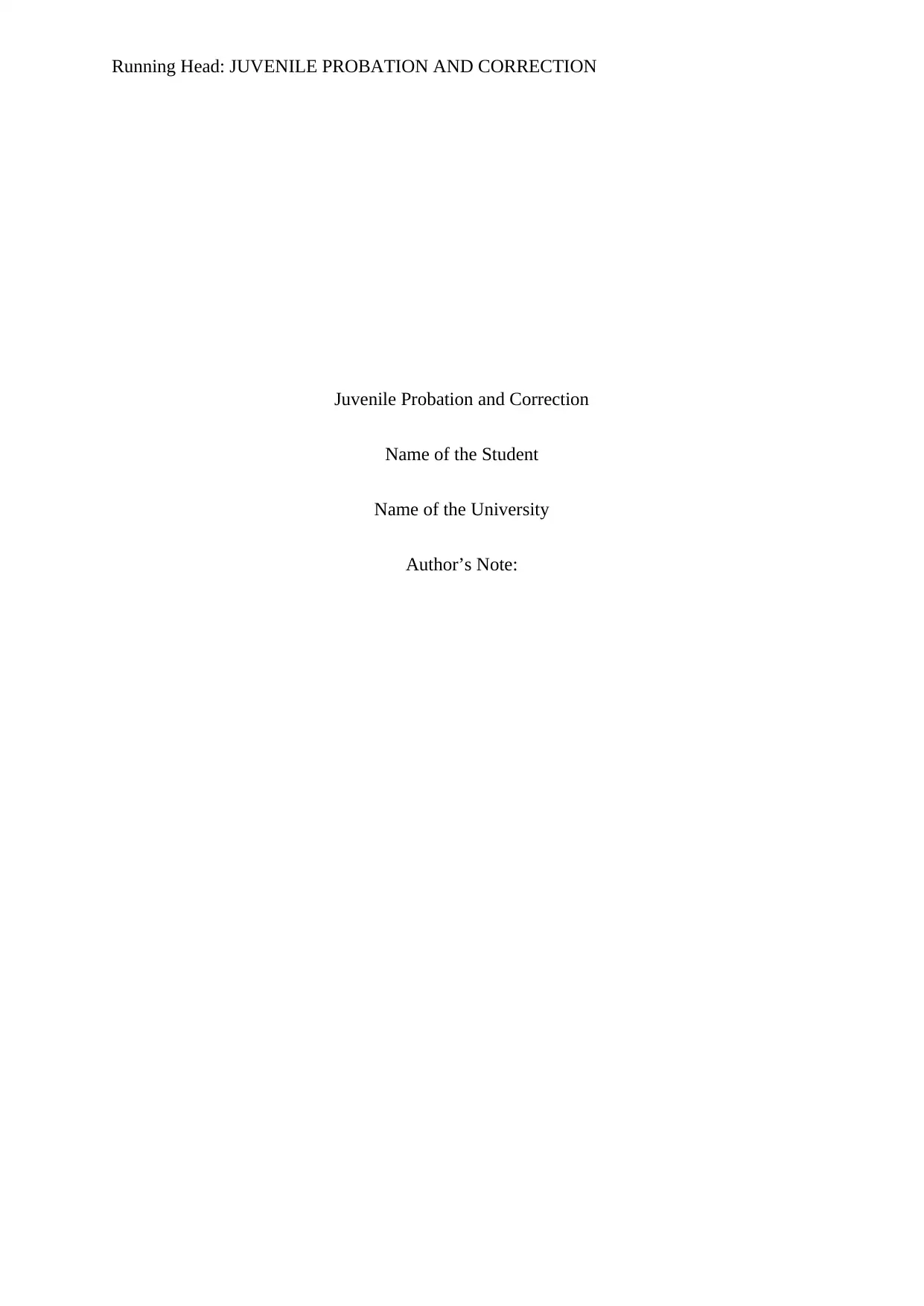
Running Head: JUVENILE PROBATION AND CORRECTION
Juvenile Probation and Correction
Name of the Student
Name of the University
Author’s Note:
Juvenile Probation and Correction
Name of the Student
Name of the University
Author’s Note:
Paraphrase This Document
Need a fresh take? Get an instant paraphrase of this document with our AI Paraphraser
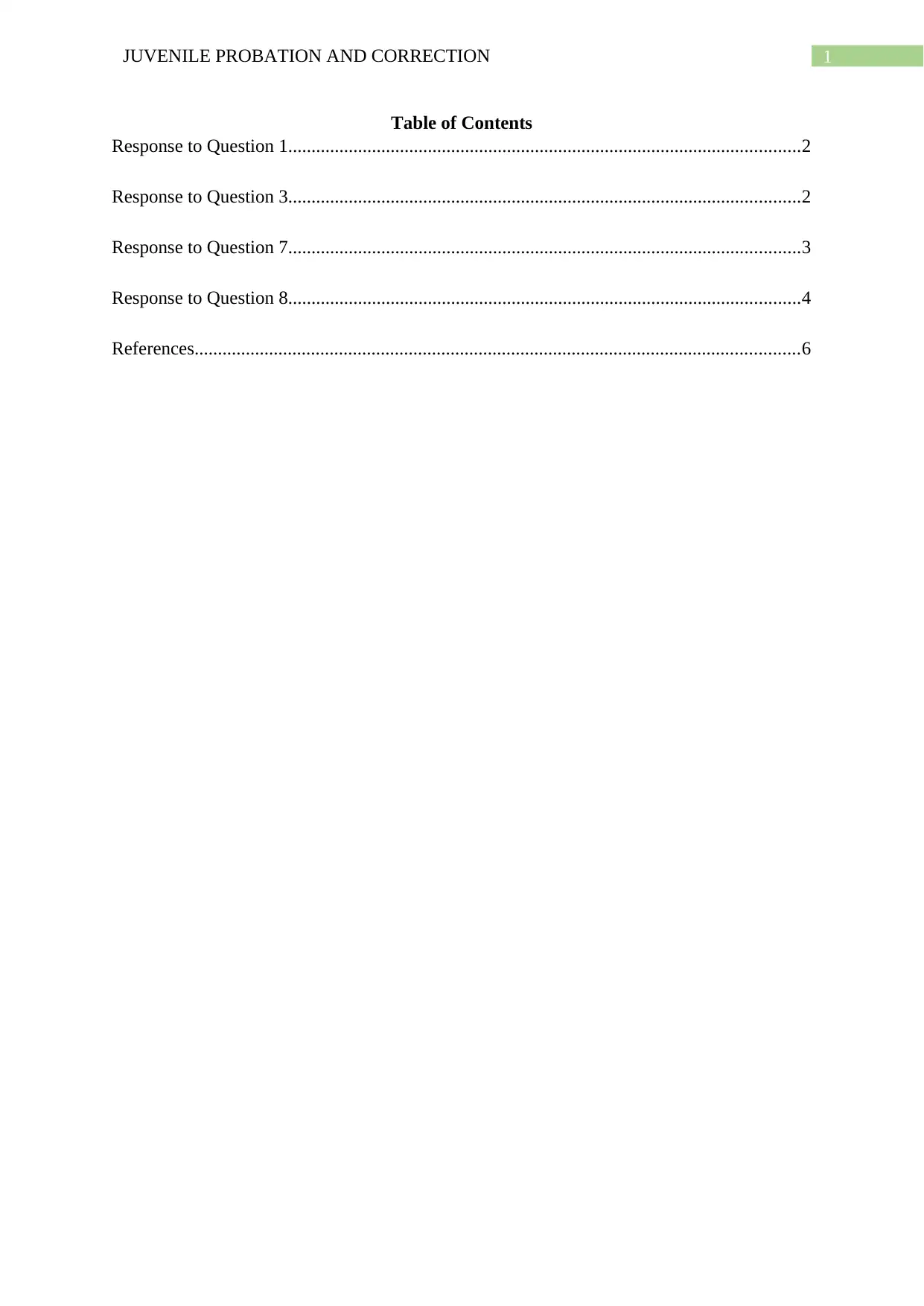
1JUVENILE PROBATION AND CORRECTION
Table of Contents
Response to Question 1..............................................................................................................2
Response to Question 3..............................................................................................................2
Response to Question 7..............................................................................................................3
Response to Question 8..............................................................................................................4
References..................................................................................................................................6
Table of Contents
Response to Question 1..............................................................................................................2
Response to Question 3..............................................................................................................2
Response to Question 7..............................................................................................................3
Response to Question 8..............................................................................................................4
References..................................................................................................................................6
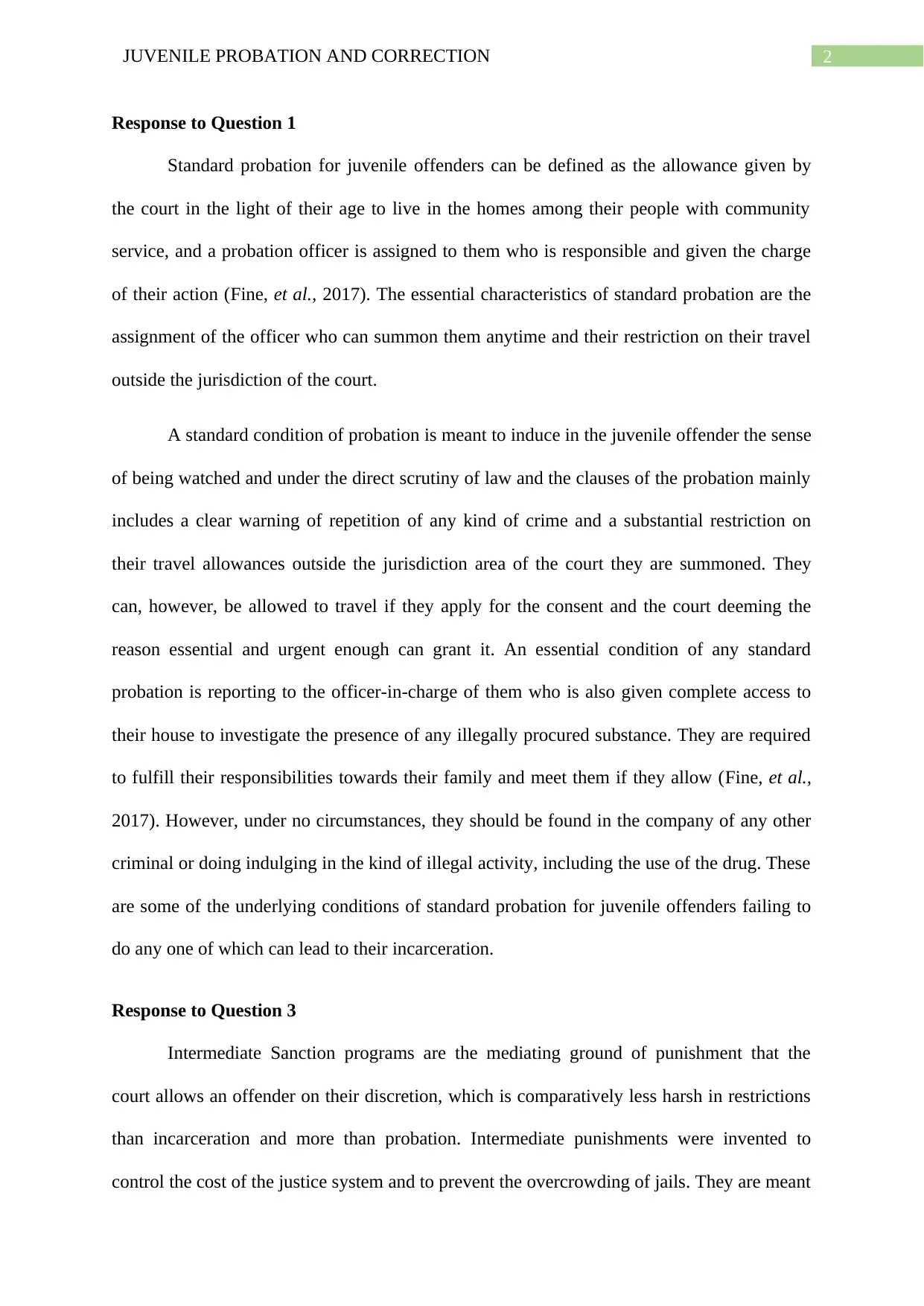
2JUVENILE PROBATION AND CORRECTION
Response to Question 1
Standard probation for juvenile offenders can be defined as the allowance given by
the court in the light of their age to live in the homes among their people with community
service, and a probation officer is assigned to them who is responsible and given the charge
of their action (Fine, et al., 2017). The essential characteristics of standard probation are the
assignment of the officer who can summon them anytime and their restriction on their travel
outside the jurisdiction of the court.
A standard condition of probation is meant to induce in the juvenile offender the sense
of being watched and under the direct scrutiny of law and the clauses of the probation mainly
includes a clear warning of repetition of any kind of crime and a substantial restriction on
their travel allowances outside the jurisdiction area of the court they are summoned. They
can, however, be allowed to travel if they apply for the consent and the court deeming the
reason essential and urgent enough can grant it. An essential condition of any standard
probation is reporting to the officer-in-charge of them who is also given complete access to
their house to investigate the presence of any illegally procured substance. They are required
to fulfill their responsibilities towards their family and meet them if they allow (Fine, et al.,
2017). However, under no circumstances, they should be found in the company of any other
criminal or doing indulging in the kind of illegal activity, including the use of the drug. These
are some of the underlying conditions of standard probation for juvenile offenders failing to
do any one of which can lead to their incarceration.
Response to Question 3
Intermediate Sanction programs are the mediating ground of punishment that the
court allows an offender on their discretion, which is comparatively less harsh in restrictions
than incarceration and more than probation. Intermediate punishments were invented to
control the cost of the justice system and to prevent the overcrowding of jails. They are meant
Response to Question 1
Standard probation for juvenile offenders can be defined as the allowance given by
the court in the light of their age to live in the homes among their people with community
service, and a probation officer is assigned to them who is responsible and given the charge
of their action (Fine, et al., 2017). The essential characteristics of standard probation are the
assignment of the officer who can summon them anytime and their restriction on their travel
outside the jurisdiction of the court.
A standard condition of probation is meant to induce in the juvenile offender the sense
of being watched and under the direct scrutiny of law and the clauses of the probation mainly
includes a clear warning of repetition of any kind of crime and a substantial restriction on
their travel allowances outside the jurisdiction area of the court they are summoned. They
can, however, be allowed to travel if they apply for the consent and the court deeming the
reason essential and urgent enough can grant it. An essential condition of any standard
probation is reporting to the officer-in-charge of them who is also given complete access to
their house to investigate the presence of any illegally procured substance. They are required
to fulfill their responsibilities towards their family and meet them if they allow (Fine, et al.,
2017). However, under no circumstances, they should be found in the company of any other
criminal or doing indulging in the kind of illegal activity, including the use of the drug. These
are some of the underlying conditions of standard probation for juvenile offenders failing to
do any one of which can lead to their incarceration.
Response to Question 3
Intermediate Sanction programs are the mediating ground of punishment that the
court allows an offender on their discretion, which is comparatively less harsh in restrictions
than incarceration and more than probation. Intermediate punishments were invented to
control the cost of the justice system and to prevent the overcrowding of jails. They are meant
⊘ This is a preview!⊘
Do you want full access?
Subscribe today to unlock all pages.

Trusted by 1+ million students worldwide
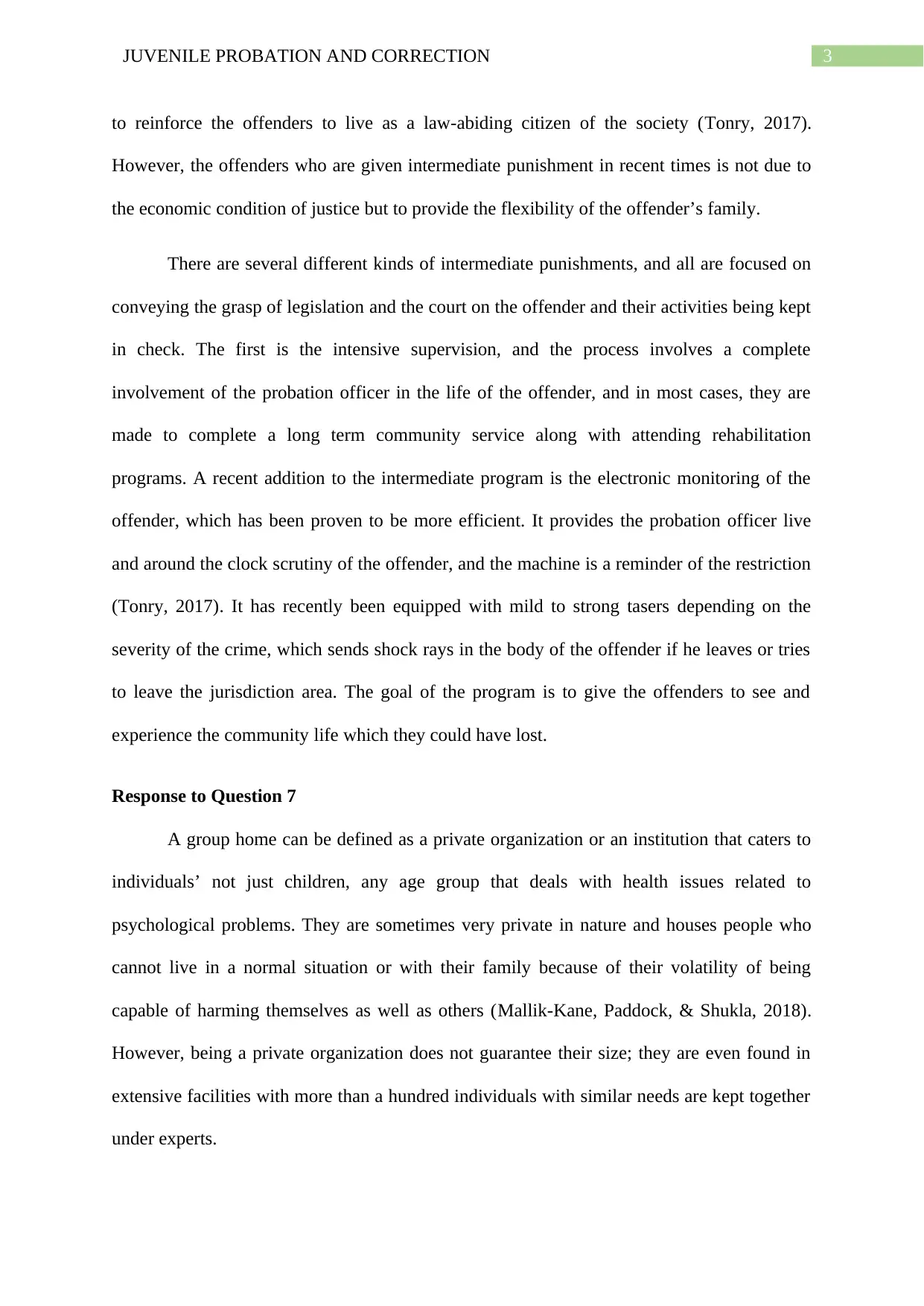
3JUVENILE PROBATION AND CORRECTION
to reinforce the offenders to live as a law-abiding citizen of the society (Tonry, 2017).
However, the offenders who are given intermediate punishment in recent times is not due to
the economic condition of justice but to provide the flexibility of the offender’s family.
There are several different kinds of intermediate punishments, and all are focused on
conveying the grasp of legislation and the court on the offender and their activities being kept
in check. The first is the intensive supervision, and the process involves a complete
involvement of the probation officer in the life of the offender, and in most cases, they are
made to complete a long term community service along with attending rehabilitation
programs. A recent addition to the intermediate program is the electronic monitoring of the
offender, which has been proven to be more efficient. It provides the probation officer live
and around the clock scrutiny of the offender, and the machine is a reminder of the restriction
(Tonry, 2017). It has recently been equipped with mild to strong tasers depending on the
severity of the crime, which sends shock rays in the body of the offender if he leaves or tries
to leave the jurisdiction area. The goal of the program is to give the offenders to see and
experience the community life which they could have lost.
Response to Question 7
A group home can be defined as a private organization or an institution that caters to
individuals’ not just children, any age group that deals with health issues related to
psychological problems. They are sometimes very private in nature and houses people who
cannot live in a normal situation or with their family because of their volatility of being
capable of harming themselves as well as others (Mallik-Kane, Paddock, & Shukla, 2018).
However, being a private organization does not guarantee their size; they are even found in
extensive facilities with more than a hundred individuals with similar needs are kept together
under experts.
to reinforce the offenders to live as a law-abiding citizen of the society (Tonry, 2017).
However, the offenders who are given intermediate punishment in recent times is not due to
the economic condition of justice but to provide the flexibility of the offender’s family.
There are several different kinds of intermediate punishments, and all are focused on
conveying the grasp of legislation and the court on the offender and their activities being kept
in check. The first is the intensive supervision, and the process involves a complete
involvement of the probation officer in the life of the offender, and in most cases, they are
made to complete a long term community service along with attending rehabilitation
programs. A recent addition to the intermediate program is the electronic monitoring of the
offender, which has been proven to be more efficient. It provides the probation officer live
and around the clock scrutiny of the offender, and the machine is a reminder of the restriction
(Tonry, 2017). It has recently been equipped with mild to strong tasers depending on the
severity of the crime, which sends shock rays in the body of the offender if he leaves or tries
to leave the jurisdiction area. The goal of the program is to give the offenders to see and
experience the community life which they could have lost.
Response to Question 7
A group home can be defined as a private organization or an institution that caters to
individuals’ not just children, any age group that deals with health issues related to
psychological problems. They are sometimes very private in nature and houses people who
cannot live in a normal situation or with their family because of their volatility of being
capable of harming themselves as well as others (Mallik-Kane, Paddock, & Shukla, 2018).
However, being a private organization does not guarantee their size; they are even found in
extensive facilities with more than a hundred individuals with similar needs are kept together
under experts.
Paraphrase This Document
Need a fresh take? Get an instant paraphrase of this document with our AI Paraphraser
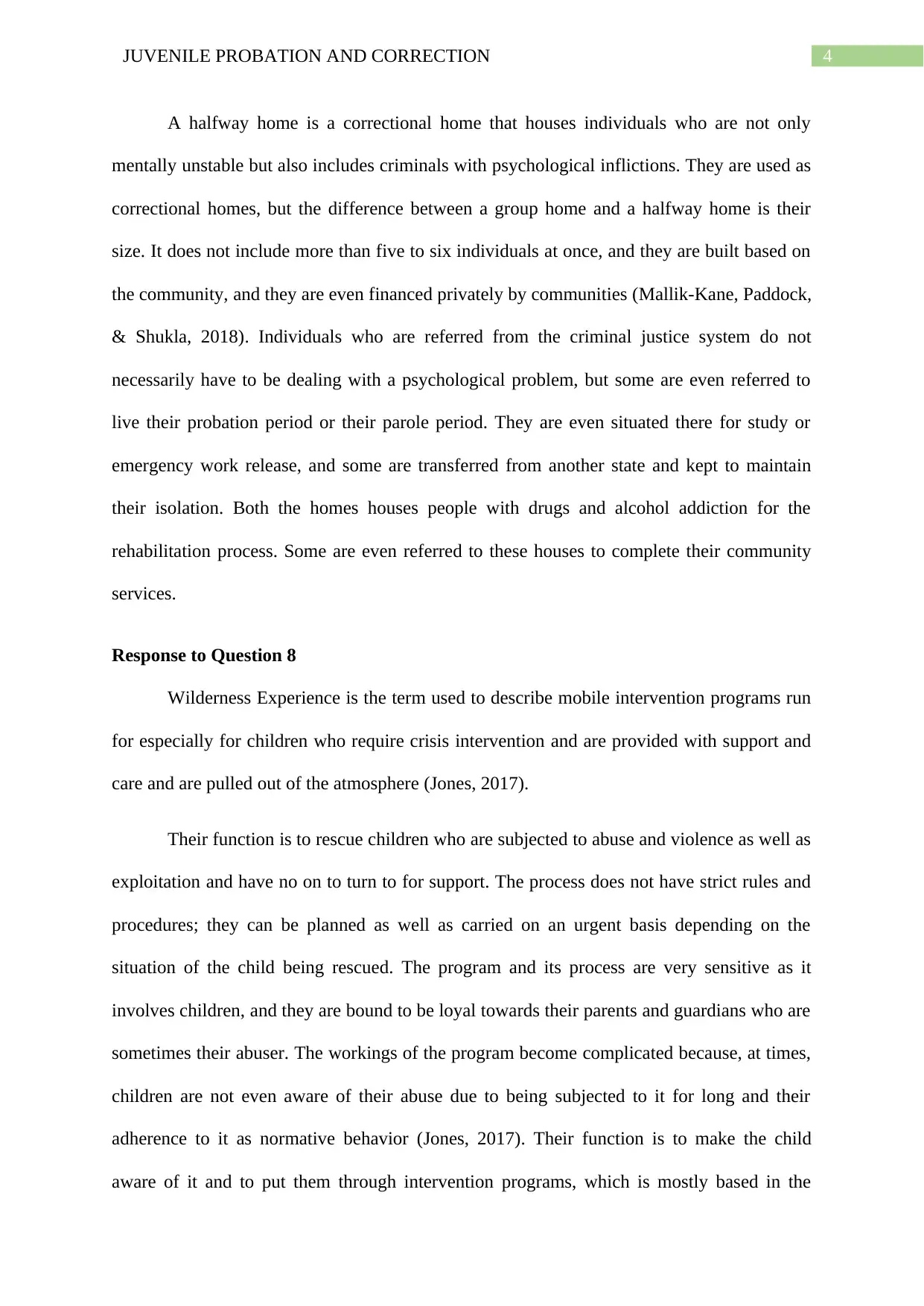
4JUVENILE PROBATION AND CORRECTION
A halfway home is a correctional home that houses individuals who are not only
mentally unstable but also includes criminals with psychological inflictions. They are used as
correctional homes, but the difference between a group home and a halfway home is their
size. It does not include more than five to six individuals at once, and they are built based on
the community, and they are even financed privately by communities (Mallik-Kane, Paddock,
& Shukla, 2018). Individuals who are referred from the criminal justice system do not
necessarily have to be dealing with a psychological problem, but some are even referred to
live their probation period or their parole period. They are even situated there for study or
emergency work release, and some are transferred from another state and kept to maintain
their isolation. Both the homes houses people with drugs and alcohol addiction for the
rehabilitation process. Some are even referred to these houses to complete their community
services.
Response to Question 8
Wilderness Experience is the term used to describe mobile intervention programs run
for especially for children who require crisis intervention and are provided with support and
care and are pulled out of the atmosphere (Jones, 2017).
Their function is to rescue children who are subjected to abuse and violence as well as
exploitation and have no on to turn to for support. The process does not have strict rules and
procedures; they can be planned as well as carried on an urgent basis depending on the
situation of the child being rescued. The program and its process are very sensitive as it
involves children, and they are bound to be loyal towards their parents and guardians who are
sometimes their abuser. The workings of the program become complicated because, at times,
children are not even aware of their abuse due to being subjected to it for long and their
adherence to it as normative behavior (Jones, 2017). Their function is to make the child
aware of it and to put them through intervention programs, which is mostly based in the
A halfway home is a correctional home that houses individuals who are not only
mentally unstable but also includes criminals with psychological inflictions. They are used as
correctional homes, but the difference between a group home and a halfway home is their
size. It does not include more than five to six individuals at once, and they are built based on
the community, and they are even financed privately by communities (Mallik-Kane, Paddock,
& Shukla, 2018). Individuals who are referred from the criminal justice system do not
necessarily have to be dealing with a psychological problem, but some are even referred to
live their probation period or their parole period. They are even situated there for study or
emergency work release, and some are transferred from another state and kept to maintain
their isolation. Both the homes houses people with drugs and alcohol addiction for the
rehabilitation process. Some are even referred to these houses to complete their community
services.
Response to Question 8
Wilderness Experience is the term used to describe mobile intervention programs run
for especially for children who require crisis intervention and are provided with support and
care and are pulled out of the atmosphere (Jones, 2017).
Their function is to rescue children who are subjected to abuse and violence as well as
exploitation and have no on to turn to for support. The process does not have strict rules and
procedures; they can be planned as well as carried on an urgent basis depending on the
situation of the child being rescued. The program and its process are very sensitive as it
involves children, and they are bound to be loyal towards their parents and guardians who are
sometimes their abuser. The workings of the program become complicated because, at times,
children are not even aware of their abuse due to being subjected to it for long and their
adherence to it as normative behavior (Jones, 2017). Their function is to make the child
aware of it and to put them through intervention programs, which is mostly based in the
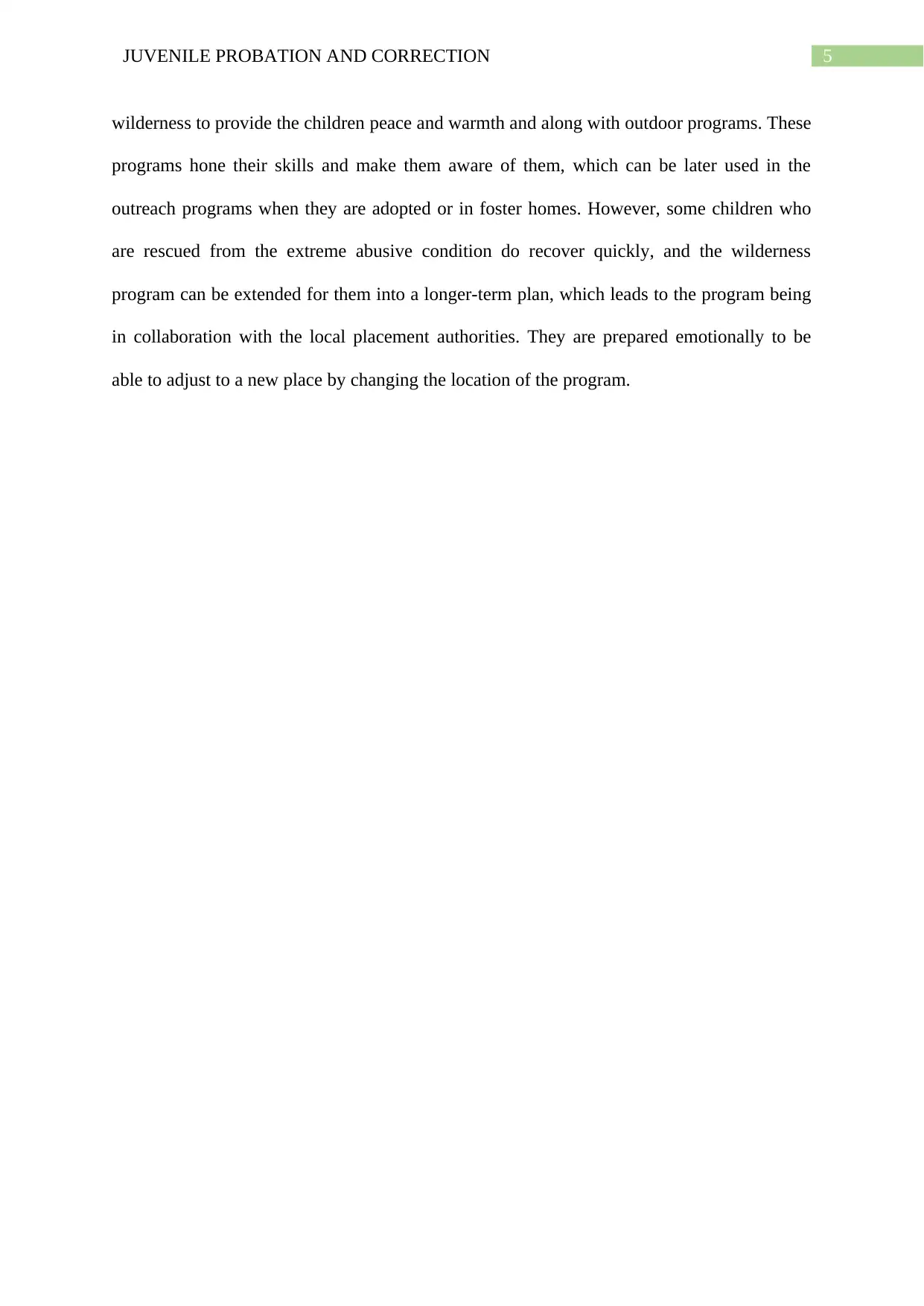
5JUVENILE PROBATION AND CORRECTION
wilderness to provide the children peace and warmth and along with outdoor programs. These
programs hone their skills and make them aware of them, which can be later used in the
outreach programs when they are adopted or in foster homes. However, some children who
are rescued from the extreme abusive condition do recover quickly, and the wilderness
program can be extended for them into a longer-term plan, which leads to the program being
in collaboration with the local placement authorities. They are prepared emotionally to be
able to adjust to a new place by changing the location of the program.
wilderness to provide the children peace and warmth and along with outdoor programs. These
programs hone their skills and make them aware of them, which can be later used in the
outreach programs when they are adopted or in foster homes. However, some children who
are rescued from the extreme abusive condition do recover quickly, and the wilderness
program can be extended for them into a longer-term plan, which leads to the program being
in collaboration with the local placement authorities. They are prepared emotionally to be
able to adjust to a new place by changing the location of the program.
⊘ This is a preview!⊘
Do you want full access?
Subscribe today to unlock all pages.

Trusted by 1+ million students worldwide
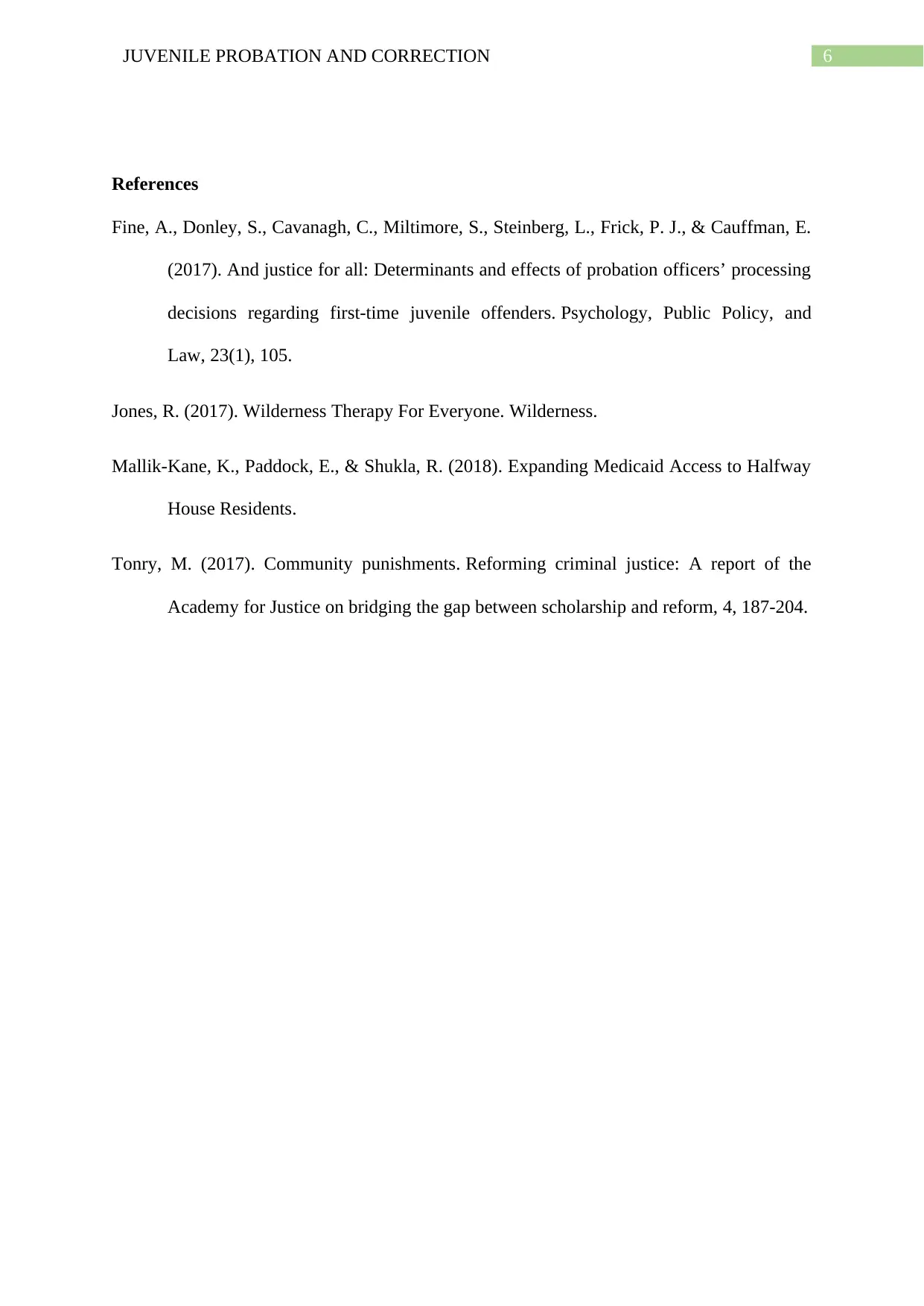
6JUVENILE PROBATION AND CORRECTION
References
Fine, A., Donley, S., Cavanagh, C., Miltimore, S., Steinberg, L., Frick, P. J., & Cauffman, E.
(2017). And justice for all: Determinants and effects of probation officers’ processing
decisions regarding first-time juvenile offenders. Psychology, Public Policy, and
Law, 23(1), 105.
Jones, R. (2017). Wilderness Therapy For Everyone. Wilderness.
Mallik-Kane, K., Paddock, E., & Shukla, R. (2018). Expanding Medicaid Access to Halfway
House Residents.
Tonry, M. (2017). Community punishments. Reforming criminal justice: A report of the
Academy for Justice on bridging the gap between scholarship and reform, 4, 187-204.
References
Fine, A., Donley, S., Cavanagh, C., Miltimore, S., Steinberg, L., Frick, P. J., & Cauffman, E.
(2017). And justice for all: Determinants and effects of probation officers’ processing
decisions regarding first-time juvenile offenders. Psychology, Public Policy, and
Law, 23(1), 105.
Jones, R. (2017). Wilderness Therapy For Everyone. Wilderness.
Mallik-Kane, K., Paddock, E., & Shukla, R. (2018). Expanding Medicaid Access to Halfway
House Residents.
Tonry, M. (2017). Community punishments. Reforming criminal justice: A report of the
Academy for Justice on bridging the gap between scholarship and reform, 4, 187-204.
1 out of 7
Your All-in-One AI-Powered Toolkit for Academic Success.
+13062052269
info@desklib.com
Available 24*7 on WhatsApp / Email
![[object Object]](/_next/static/media/star-bottom.7253800d.svg)
Unlock your academic potential
Copyright © 2020–2025 A2Z Services. All Rights Reserved. Developed and managed by ZUCOL.


